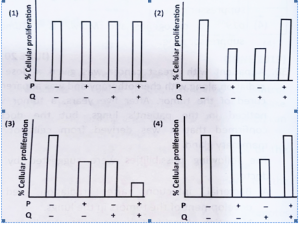39. Virus infects a particular cell type, integrates its genome into a site that contains a proto-oncogene, transforms the cell and increases the level of a protein ‘X’, which increases cellular proliferation. A compound ‘P’ is known to increase the level o tumor suppressor proteins in that cell type whereas a compound ‘Q’ helps in stimulating a protein Z .that can bind to ‘X’ rendering
it inactive. Which one of the following graphs correctly represents the mode of action of ‘P’ and ‘O’?

Based on the description and typical modes of action for compounds targeting oncogenic viral effects on proto-oncogene products and tumor suppressors:
-
Virus integration near a proto-oncogene leads to increased expression of protein X, which drives proliferation (an oncogene effect).
-
Compound P increases tumor suppressor protein levels, which inhibit proliferation.
-
Compound Q stimulates protein Z, which binds to the oncogenic protein X, rendering it inactive (a direct inhibition).
The expected pattern is:
-
Protein X levels increase due to viral activation (high initial level).
-
Compound P will reduce proliferation by increasing tumor suppressors, so proliferation decreases.
-
Compound Q will directly bind and inhibit X, also reducing proliferation.
Therefore, the correct graphical representation would show:
-
High X in virus-infected cells.
-
Reduced proliferation when P is applied (tumor suppressor upregulation).
-
Reduced proliferation also when Q is applied (X inhibition).
This corresponds to graphs where treatment with P or Q leads to lower proliferation compared to virus alone.



